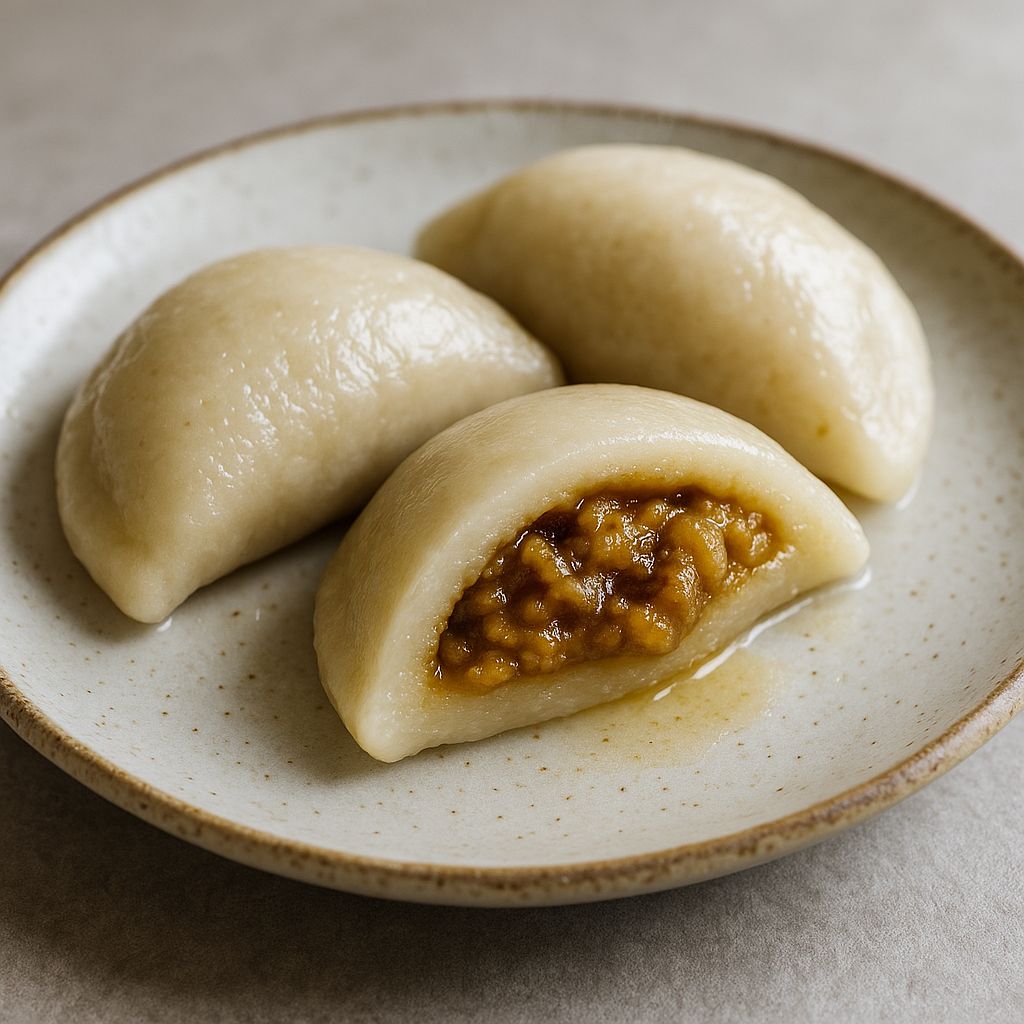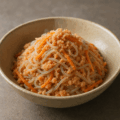きんかもちの特徴
南部地方に伝わる粉もの文化の郷土菓子
きんかもちは、小麦粉の生地でくるみ・黒砂糖・味噌の餡を包み、半月形に整えて茹でる青森・南部地方の行事菓子。つるんとした生地に、甘じょっぱい餡がよく合います。
名の由来と別名
黒砂糖がかつて高価な贅沢品だったことから「金貨餅」と呼ばれたと伝わります。形から「ばほりもち」「かますもち」「みみっこもち」「かい(貝)こもち」などの別名もあります。
盆・年取りのお供え、農作業のおやつにも
各家庭で100年以上作られてきた歴史があり、送り盆や年取り(大晦日)の供え物として欠かせない一方、農作業の合間のおやつとしても親しまれてきました。
きんかもちのレシピ
材料(約10個分)
- 生地:小麦粉 300g/塩 小さじ1/3/熱湯 約400ml
- あん:くるみ 50g(粗みじん)/味噌 17g/黒砂糖 100g
作り方
- 生地:小麦粉に塩を混ぜ、熱湯を加えて耳たぶ程度にこねる。
- 生地を1個約90gに分け、打ち粉をして丸め、中央をくぼませる。
- 包む:生地の内側に味噌を薄く塗り、くるみと黒砂糖を各小さじ1弱ずつ入れて半月形に包む。
- 茹でる:沸騰湯でゆで、浮いてから3〜5分。取り出して水にくぐらせる(照りが出る)。
シェフのワンポイントアドバイス
生地は熱湯でこねて耳たぶ硬さが目安。茹で上がり直後の餡は非常に熱いので火傷に注意。
黒砂糖の量で甘さを、くるみの粗さで食感を調整しましょう。
歴史
冷害が育んだ粉もの文化から
稲作が難しい年に備えて小麦・雑穀が広まった南部地方で生まれ、贅沢な黒砂糖と手間のかかるくるみを用いるため、特別な日の行事菓子として受け継がれてきました。
食べ方の所作
そのまま“かぶりついて”食べるのが定番。中の餡が熱く、とろりとはみ出しやすいので最初はゆっくり食べてください。
English Version
Features of Kinka-mochi
A flour-based folk sweet from the Nanbu region
Kinka-mochi is a ceremonial sweet from Aomori’s Nanbu area: wheat dough wrapped around a filling of walnuts, brown sugar, and miso, shaped into a half-moon and boiled. The silky dough pairs beautifully with the sweet–savory filling.
Name origin and alternate names
It is said to be called “kinka” (“gold coin”) because brown sugar was once a luxury item. Owing to its shape, it is also known as “bahori-mochi,” “kamasu-mochi,” “mimikko-mochi,” and “kaiko-mochi (shell-mochi).”
Offerings for Obon and New Year’s Eve—also a farm-day snack
Made in households for over a century, it is indispensable for Obon send-offs and “toshitori” (New Year’s Eve) offerings, and it has long been enjoyed as a snack during breaks in farm work.
Recipe
Ingredients (about 10 pieces)
- Dough: Wheat flour 300 g / Salt 1/3 tsp / Boiling water about 400 ml
- Filling: Walnuts 50 g (coarsely chopped) / Miso 17 g / Brown sugar 100 g
Instructions
- Dough: Mix flour and salt; add boiling water and knead until earlobe-soft.
- Divide into pieces of about 90 g each, dust with flour, roll into balls, and press a hollow in the center.
- Fill: Lightly spread miso inside, add just-under-1 tsp each of walnuts and brown sugar, and seal into a half-moon.
- Boil: Cook in boiling water; after they float, boil 3–5 minutes more. Remove and briefly dip in water for a glossy finish.
Chef’s Tip
Knead the dough with boiling water to an earlobe-like firmness. The filling is extremely hot right after boiling—take care. Adjust sweetness with the brown sugar amount and texture by how coarsely you chop the walnuts.
History
From a flour culture shaped by cold-weather crop failures
In the Nanbu region—where wheat and millets spread as a hedge against poor rice harvests—this special-occasion sweet took root, using precious brown sugar and labor-intensive walnuts.
How to eat
The classic way is to bite right in. Since the filling is hot and can ooze, start slowly and savor it.



何でも質問してください!